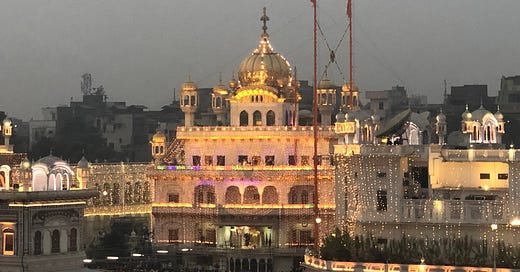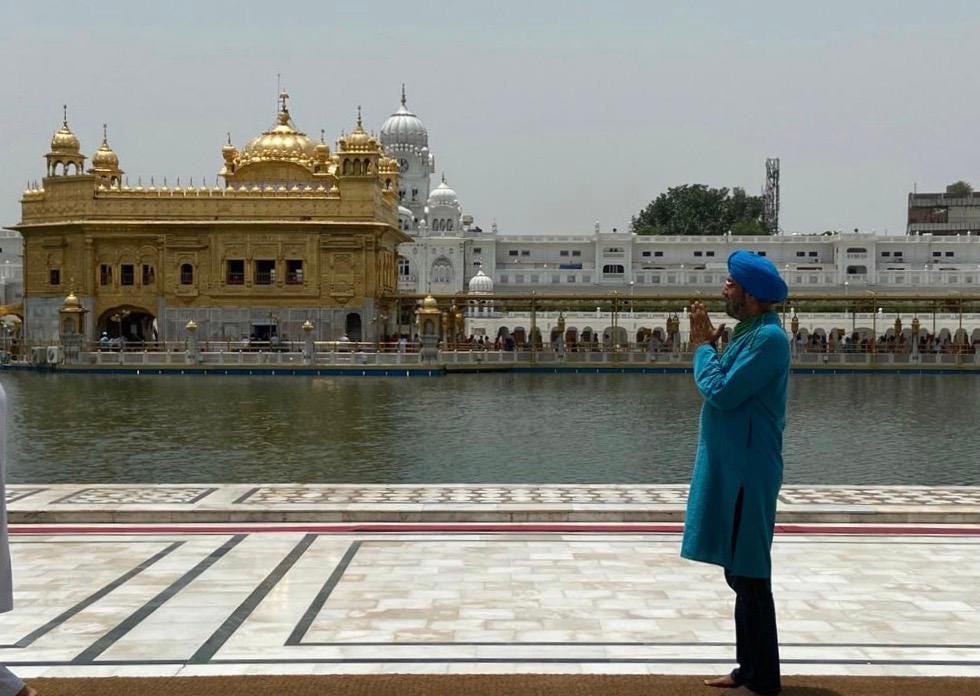The Miri-Piri Doctrine and Jathedari of Sri Akal Takht
Responding to the Debate on Sikh Institutional Legacy.
By Karan Bir Singh Sidhu, Retired IAS
Introduction: A Divergence of Views in the Panth
A recent and impassioned exchange within a Sikh intellectual forum revealed a pronounced divergence in views regarding the historical and theological legitimacy of Jathedari, particularly the position of Akal Takht Sahib and its custodians.
One school of thought argues that the contemporary office of Jathedar is a political construct—either a colonial residue or an Akali-era invention—lacking an unbroken lineage from the times of the Gurus. To them, its relevance is diminished by politicisation, inconsistency, and a lack of scriptural anchorage.
The opposing view, which I endorse, holds that the institution of Jathedari is neither accidental nor artificial. Rather, it is a natural and conscious outcome of the Miri-Piri doctrine enunciated by Guru Hargobind Sahib Ji in 1606. There is ample historical, symbolic and practical evidence to show that this was no fleeting gesture but the planting of a sapling—nurtured across centuries—that has grown into a robust tree of Sikh leadership and collective conscience. The institution did not emerge in a vacuum; it evolved through praxis, sacrifice, and an enduring theological vision.
Miri and Piri: The Twin Pillars of Sikh Sovereignty
The martyrdom of Guru Arjan Dev Ji marked a pivotal transition in Sikh history. In response, Guru Hargobind Sahib Ji institutionalised the concept of Miri (temporal authority) alongside Piri (spiritual sovereignty). He adorned two swords, constructed the Akal Takht opposite the Harmandir Sahib, and declared an unambiguous blending of devotion and resistance.
This doctrine was neither rhetorical nor passive. It asserted that a Sikh must be spiritually grounded yet prepared to defend righteousness and the dignity of the community. The Akal Takht became the physical seat of this dual authority, from where edicts could be issued and decisions affecting the Panth deliberated.
The Sword Drawn: Guru Hargobind Sahib Ji’s Military Campaigns
The practical application of the Miri-Piri doctrine came through a series of pivotal battles, each reinforcing the dual role of the Guru as spiritual guide and temporal sovereign. Guru Hargobind Sahib Ji’s transformation of the Sikh community into a disciplined force was not theoretical—it was forged through fire.
1. Battle of Rohilla (1621)
Fought against the Mughal governor Abdul Khan of Jalandhar, this battle was sparked by the Mughals' attempts to suppress Sikh gatherings. Guru Hargobind’s forces triumphed, establishing Sri Hargobindpur as a fortified town—both a spiritual centre and a military bastion.
2. Battle of Amritsar (1628)
A major confrontation in which Mughal commander Mukhlis Khan, acting on Emperor Shah Jahan’s orders, attacked Amritsar. The Sikhs defended the city and the Akal Takht complex with valour, repelling the assault and marking one of the earliest defences of Sikh sovereignty.
3. Battle of Sri Hargobindpur (1630)
This battle saw the Guru leading from the front against Mughal General Abdulla Khan and his allied Hindu chieftains. Both of Abdulla Khan’s sons were slain in combat. The Sikh victory strengthened their grip over the Doaba region and demonstrated the Guru’s command over both strategy and morale.
4. Battle of Kartarpur (1635)
Guru Hargobind Sahib Ji’s resolute refusal to submit to Mughal-imposed taxation led to a decisive confrontation at Kartarpur. The Mughal forces, commanded by General Painde Khan—a former associate turned adversary—and supported by the notorious informer Chandu’s son, launched an aggressive campaign to crush Sikh defiance. However, the Guru’s forces not only withstood the assault but delivered a crushing blow: both Painde Khan and Chandu’s son were slain in battle. The encounter marked a turning point, forcing the Mughal Empire to reckon with Sikh military strength and political autonomy—acknowledging, at least in practice if not by decree, the emergence of a sovereign Sikh presence.
5. Skirmishes at Kiratpur and Ropar (1634–1644)
Following these battles, Guru Hargobind moved to Kiratpur Sahib in the Shivalik foothills, where he oversaw further engagements—most notably with Pathan mercenaries near Ropar. These culminated in what is remembered as the Battle of Kiratpur, again affirming that Sikh resistance was not just urban or symbolic, but also geographically adaptive and rural-based.
These battles were not driven by conquest but by the Guru's commitment to defend the faith, the community, and the principle of justice. They validated the Miri-Piri ideal in real-world terms, blending sword and scripture in one sovereign vision.
The Jathedar: Evolution, Not Invention
The appointment of Bhai Gurdas Ji as the first custodian of the Akal Takht in 1606 laid the cornerstone for what would become the institution of Jathedar. His role was comprehensive—he managed spiritual deliberations, handled correspondence, and advised the Guru on matters of governance.
Later, Bhai Mani Singh Ji, Baba Deep Singh Ji, and Akali Phula Singh Ji embodied this mantle, defending Sikh institutions against heresy, invasion, and internal decay. At no point did these custodians act outside the framework of Guru's vision. Rather, they were the loyal messengers of the ‘Gurmat’.
To argue that Jathedari is a 20th-century fabrication, or even a British-era construct, is to ignore the lived experiences, sacrifices and decisions that shaped the very character of Sikh collective life.
Colonial Disruptions and Post-Partition Drift
That said, it must be acknowledged that the colonial era disrupted traditional Sikh institutions. The creation of the SGPC on a statutory basis in 1925 (following the non-statutory society in 1920, which had Sir Sundar Singh Majithia as its Founder-President) brought administrative structure but also political baggage. In the post-independence period, the office of Jathedar became entangled in Akali politics, with appointments often driven by expediency rather than Panthic consensus.
However, these institutional deformities do not delegitimise the concept of Jathedari. They underscore the need for reform, not erasure. The call of the hour is to insulate Sri Akal Takht Sahib from factional pressures and restore its credibility—not to question its existence.
An Institution That Did Not Arise in a Vacuum
The argument that Jathedars are a recent invention ignores a rich and traceable history. From the founding of the Akal Takht to the present day, the conceptual lineage remains intact. The personnel and the politics may have fluctuated, but the institutional intent has not.
There is enough evidence—textual, symbolic, martial and spiritual—to affirm that this institution is not a hollow shell. It is a living organism that has evolved alongside the Sikh Panth, adapting to its needs and responding to its crises. The Jathedar, as envisioned, is not a king nor a priest, but a servant-leader of the Khalsa.
Faith, Not Archaeology
In our quest for historical exactitude, we must not fall into the trap of archaeological scepticism. Just as neither the Vatican nor the Protestant Churches have felt compelled to commission expeditions into the so-called “Lost Years of Christ”, so too must the Sikhs resist reducing their sacred institutions to subjects of empirical excavation.
The Akal Takht and the institution of Jathedari are not relics to be exhumed. They are living embodiments of Guru Sahib’s vision, sanctified by tradition and reaffirmed by history. The danger lies not in continuity, but in cynicism.
Summing Up: Reform, Not Rejection
The ongoing debate within the Sikh community—though at times unsavoury—is both timely and essential. It signals a rising collective yearning for transparency, moral clarity, and institutional relevance. However, the path forward does not lie in delegitimising the office of the Jathedar, but in reclaiming its lost integrity and restoring it to its rightful stature within the Panth.
Let us not uproot the tree because some of its branches are diseased. Let us prune it with care, nurture it with vision, and anchor it more firmly in the soil of Gurmat, history, and collective wisdom.
The Miri-Piri doctrine is not merely a theological abstraction—it is the bedrock of Sikh sovereignty, resilience, and collective self-respect. It demands not only remembrance but continual reaffirmation. Neither Miri-Piri, nor the institution of the Sri Akal Takht and its Jathedar, are recent constructs or administrative innovations. Though the form may have evolved over time, their origin lies directly in the vision of Guru Hargobind Sahib Ji, and their spirit flows unbroken through the eras of the later Gurus, including Guru Gobind Singh Ji, and well beyond. They are not artefacts of history, but living legacies, anchored in divine purpose and Panthic continuity.





